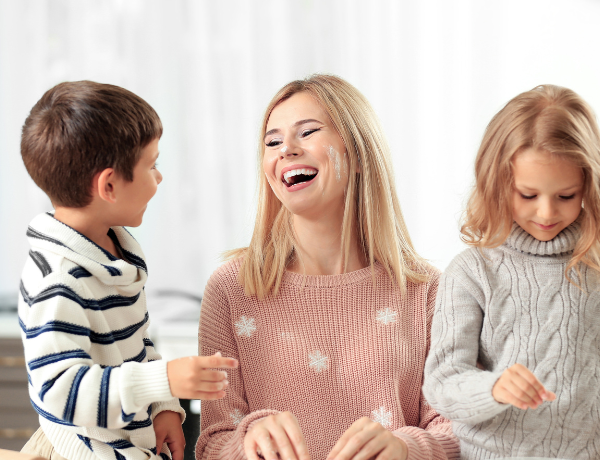Calming the Chaos: Stress-Reducing Strategies for Children During the Holiday Hustle

Calming the Chaos: Stress-Reducing Strategies for Children During the Holiday Hustle
For all children, the whirlwind of holiday activities can pose unique challenges. This is especially the case of those with anxiety, ADHD, and other disorders. The increased stimulation from decorations, busy social gatherings, and altered schedules may cause increased sensory disruption and overwhelm. This can lead to more anxiety and stress. The change in routine that accompanies the holiday season is especially impactful. Routines act as stabilizing anchors, providing a sense of predictability and structure. The festive period comes with altered school schedules, new family routines, possible vacations, and changes in extracurricular activities. The school break, while being much needed, is also a source of disruption from typical routine, and can be overwhelming for many.
Children thrive when they are in a structured environment. Any change to their regular routine can make it challenging to maintain attention, get healthy sleep, and regulate big emotions. Some children may not be aware of the relationship between their increased anxiety and the holidays. This makes it important for parents, teachers, and other family members to maintain support during this time.
Planning becomes essential for maintaining a sense of predictability amid the seasonal chaos. It helps to create a supportive environment for children. It becomes crucial for parents to collaborate with their children in establishing a holiday routine that incorporates a balance between festive activities and essential tasks. This way, everyone can enjoy the holiday season!
Strategies for Navigating Routine Change:
- Create a holiday themed visual schedule: Visual schedules are very helpful for children to anticipate what their day will look like. They create a sense of predictability and stability, and they can help prepare children for transitions during their day. Making a visual schedule with your child can help them feel in control of their day and excited about what is to come.
- Anchor Activities: Identify “anchor” activities that remain consistent regardless of the holiday festivities. Examples can be a morning walk, shared reading time, or a favorite game. The anchor activities provide a sense of stability among many other changes in routine.
- Involve children in planning: Asking for input from your child on holiday activities and traditions can help create a sense of control and excitement for the holiday season.
- Encourage open communication: Let your children know that it is okay to express their emotions (in appropriate ways) and validate their feelings. Many children may not know that the source of their stress and behaviors can be due to disruption to routine and busy holiday schedules. Help them make the connection. Be realistic about what they can accomplish.
- Keep planning balanced: Prioritize important activities, but keep routines simple and realistic. Too many or too little activities can cause overwhelm and exhaustion, which can increase unexpected behaviors. Ensure breaks are scheduled on days that are more eventful than others.
- Maintain a healthy sleep schedule: The holiday season can be very disruptive to children’s regular bedtime routines. Disruption to sleep can exacerbate anxiety and other big emotions. Maintaining a regular bedtime is very helpful to keep a regular routine in place and keep children well rested and ready for a new day of activities.
Despite a parent's best efforts to establish routines, there may be moments when the holiday excitement becomes overwhelming. Be vigilant for signs of stress, which can manifest as:
- Internalized symptoms such as: social withdrawal, feelings of loneliness or sadness, unexplained stomach aches, nervousness, and irritability.
- Externalized symptoms such as: increases in aggression, defiance, “temper tantrums”, or increased impulsive behavior.
These behaviors can all be related to overwhelm and stress. They are often demonstrated to express stress when words cannot.
Having a “toolbox” of strategies for emotional regulation in place for when children feel overwhelmed can help them get through their stress and come back to baseline.
Strategies for an emotional regulation “toolbox”:
- Model healthy emotional regulation strategies and expected behaviors: Children learn by observing, so it is essential to model healthy emotions and remain calm during times of increased stress. Show your child how to manage stress and emotions in a constructive way.
- Practice deep breathing: Strategies such as “Figure 8 Breathing” or “Box Breathing” are easy strategies parents can practice at home with their children to model a healthy coping strategy.
- Try “progressive muscle relaxation”: “PMR” is a strategy that can help children manage stress and promote relaxation. It involves a systematic process of tensing and then gradually releasing different muscle groups in the body. This can help your child reduce physical stress in the body, and can be made fun with various child friendly language and scripts.
- Encourage physical activity: Physical activity is a scientifically supported way to reduce stress and anxiety in children. Simply going for a daily walk to get moving can help support overwhelm and stress. The winter break may also offer the opportunity to engage in new physical activities. Holiday activities can include:
- Going skating
- Sledding and tobogganing
- Cross country skiing
- Building a snowman or igloo
In summary, a comprehensive approach to managing holiday overwhelm for children involves a combination of:
- structured activities,
- awareness of the signs of overwhelm and stress,
- clear communication, and
- implementation of healthy and simple coping strategies.
By tailoring strategies to address the unique needs of each child, families can ensure that the holiday season is a time of joy and celebration, fostering a positive experience for children and their loved ones.
Further Information:
- ADHD and Emotional Regulation: https://www.additudemag.com/emotional-dysregulation-adhd-video/
- 11 ADHD Holiday Tips: https://www.understood.org/en/articles/11-tips-to-help-kids-with-adhd-manage-the-holidays
- Managing Holiday Stress in Children: https://www.health.harvard.edu/blog/7-ways-prevent-holiday-stress-children-2017112812809
- How to Make Holidays Kid-Friendly: https://childmind.org/article/how-to-take-the-stress-out-of-the-holidays/
What about Parenting with ADHD during the Holidays?
Safely Home for the Holidays https://chadd.org/adhd-news/adhd-news-caregivers/safely-home-for-the-holidays/
Holiday Stress and Adult ADHD https://www.additudemag.com/when-adhders-take-on-the-holidays-we-always-lose/
